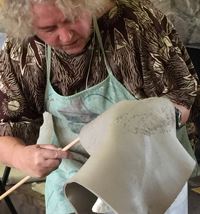 By Judy Nelson-Moore
By Judy Nelson-Moore
With an interview by Slip Trail editor Cirrelda Snider-Bryan on October 11, 2023
Judy Nelson-Moore: It is difficult to decide where to start my story about my involvement in the NMPCA. Should I start with attending the New Mexico Potters Ghost Ranch workshops in the late 1980s while living in Denver? Should I start with when I became a member of the NMPCA board after moving to Santa Fe about 32 years ago? …
Wherever I start, this story about me is also about the NMPCA and its growth, expansion, and success over the last 25 years. I have been a player in this success, having served on the board for 20 years and in various capacities on committees. I am proud of what we have accomplished and extremely grateful for the friendships I have gained from long-standing and recent introductions. If I were to mention the names of all the friends I have made it would nearly make for a roster of members. These friendships have enriched my life immeasurably, and I can’t imagine my life without them now.
The greatest observation I can make about the NMPCA, if I take a long view, is the increased quality and variety of ceramic art expression exhibited by members. If you come to each of the exhibitions put on by the NMPCA for 20 years, as I did, this fact becomes very apparent. New members have brought in new forms of expression, workshops have encouraged ideas and excellence, and individual members have put forth their best efforts to improve their work.
The Slip Trail: You talk about the greatest observation you can make about the NMPCA being “increased quality and variety of ceramic art.” Within that context, please discuss your history with the Celebration of Clay, the annual exhibition.
Judy Nelson-Moore: NM Potters, for a time, held their annual member shows at the Harwood Art Center in Albuquerque, with the name “Celebration of Clay.” Here is the flyer for the 2003 show, for which I was an award juror. Elaine Biery won Best of Show that year, and you can see the pictures of other awards. There was never an overt jurying process in those early Celebrations of Clay. Members were notified of the show, and if any pieces were ever rejected, I didn’t know about it. It was mainly organized in Albuquerque with Kathy Cyman and others.
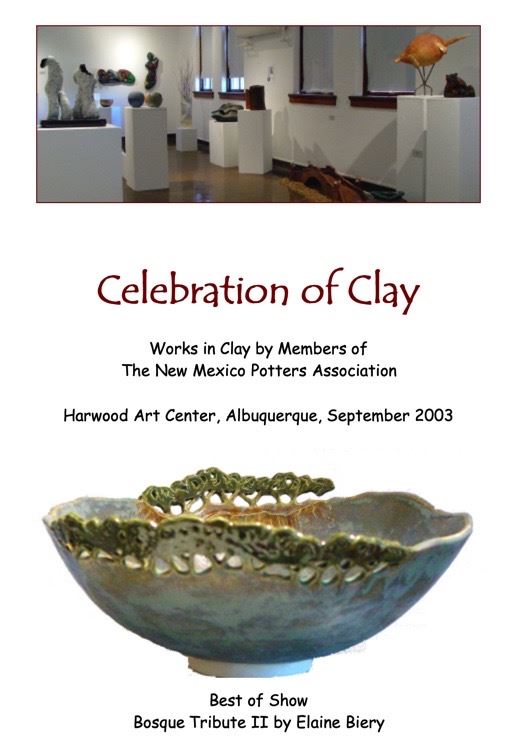
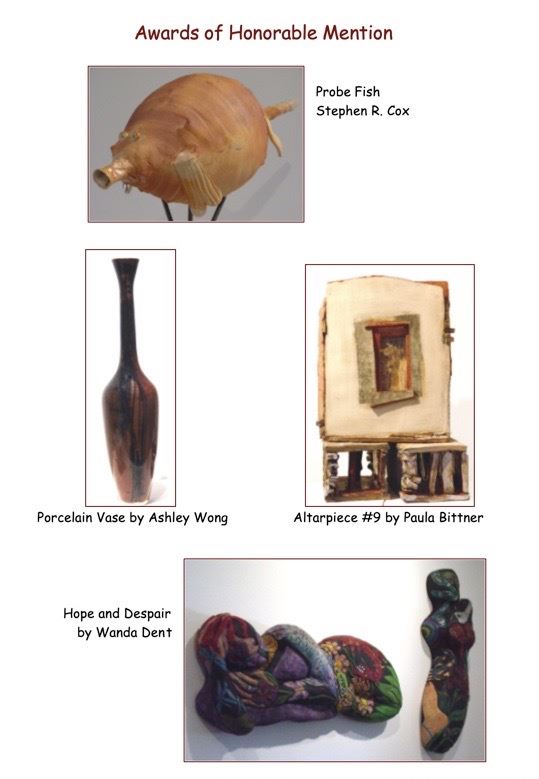
Celebration of Clay 2003 flyer.
Not too long after, the annual exhibition moved to the Albuquerque Arts Alliance Gallery, where Cricket Appel, then president of the NMPCA, was also the director of the Albuquerque Arts Alliance. The Arts Alliance had a gallery with their office, and we started showing there. And at that time, we overtly discussed it would not be a juried show. I was mainly in favor of that because I had had two previous experiences with craft organizations where juried exhibitions created a poisonous bitterness. In one case, the organization died because the acrimony devolved into disinterest. I felt the NMPCA should not have the same fate! NMPCA should be very inclusive. The whole purpose of our organization was to build up the ceramic arts and encourage artists. From my previous experience, I felt a juried show was contrary to that purpose. Fortunately, many of the other members agreed. Several years later, I was validated by learning that renowned artist and teacher Robert Henri, who worked with Edgar Hewitt in 1917 during the founding of the Museum of New Mexico, implemented an open-door policy for the exhibitions without jurying because he felt judgments were the antithesis of creativity and artist’s development.
From Robert Henri, The Art Spirit, published in 1923:
“…To struggle for an open forum for exhibition without the control of juries, and for greater opportunity all, for self-education…. there will grow new and wonderful things”
I’ve long fought for what I called “the self-juried show.” I said each artist should submit their work to the Celebration of Clay, where they can imagine themselves standing at the opening, having their picture taken, and feeling proud of their submittal. I call that “self-jurying.” Over the years, the NMPCA’s conduct of their annual exhibition has proven the success of the “self-juried” show concept ... We had some difficulty finding venues who would accept the idea early on, but the venues realized a quality show could still be staged because we had demonstrated it for many years. You can look at specific artist’s work from years ago and then look at their work now, and you can see a fabulous progression.
The Slip Trail: How was the Clay Community back in 1992 here in New Mexico, especially Santa Fe when you moved there. Was it more fragmented? The reason I ask that is because in your outline you state there was a Santa Fe Potters Guild and at one point it merged with NM Potters and Clay Artists (at that time it was just called New Mexico Potters). What’s the story about Santa Fe Potters Guild merging with NM Potters?
Judy Nelson-Moore: When I first came to Santa Fe in 1992, I was really very busy with my computer software consulting business, I was doing a lot of travel. My husband, Jim, and I were also building a house. Of course, the house has a wonderful clay art studio! At this time, I also continued working with paper clay. This is adding paper pulp to the clay body to increase the dry strength. I have been exploring this concept ever since with my own work and conducting workshops.
However, I was struggling with integrating into the community in Santa Fe, partly because I was traveling a lot and missed the ceramic art community in Denver. There, we had a very active community of ceramic artists; I was a member of the Colorado Potters Guild, a very close group. I found in Santa Fe there was a Santa Fe Potters Guild which held meetings and sales. I joined and since I was a computer software specialist, I did their email list. However, I found the atmosphere in Santa Fe at the time was kind of standoffish. Artists were protective of their techniques and opportunities because of the great competition. There were so many artists. It seems there’s much space in Santa Fe for art, but there was a lot of competition for the opportunities. It still is that way. At Denver galleries, you could do better as a Santa Fe artist than you could in Santa Fe as a Santa Fe artist. Something about an out-of-town artist has a draw for galleries.
A fellow Santa Fe Potters Guild member and I, Jay Dirago, decided we would like a more open, sharing atmosphere. So, we started an informal group called The Clay Salon. We would invite clay artists into a studio, his studio, my studio, and other studios followed. We would gather around in a circle, and we would exchange ideas. We shared glaze recipes, inspiration, tools, working methods, and gallery contacts: the idea was to share ceramic art experiences.
I also continued to be a member of the New Mexico Potters. (I had been a member for years from Colorado.) Gary Carlson (NM Potters president at the time) talked me into doing the email list for the NM Potters. So, I was doing the email list for the Santa Fe Potters Guild, our Clay Salon, and the New Mexico Potters. The Santa Fe Clay Guild folded, and I told everyone I was not going to maintain overlapping lists anymore, so I told people they should just join the New Mexico Potters. Most people did, and we continued to hold the Clay Salon in Santa Fe, even having some people join us from Albuquerque. I see the Zoom Clay Connections which we started during COVID-19 as a continuation of the impetus to share ceramic art experiences, expanded to the whole membership around the state.
So, you could say my software consultant career let me make major contributions to the New Mexico Potters and Clay Artists over the years. First with the email lists and sending emails, then with website creation and maintenance, leading to my idea to have an online “studio tour” of artists on the website, then online membership records, online event registrations, online donation campaigns, exhibition displays, people’s choice voting for exhibition works, and conversion of the paper/email “Slip Trail” to the current blog. I think these initiatives have helped to keep the organization vital and growing. I am grateful to the active participation of the membership, especially fellow board members, past and present for their support. I am very thankful for Sara D’Alessandro for taking over the newsletter. Michael Thornton for taking over the Ghost Ranch Coordination, and Leonard Baca for taking over the website.
The Slip Trail: Ghost Ranch became an important place for you to connect with other potters and learn from them. Please talk about the ways you remember having the NMPCA organization help the Ranch be a place for Clay Community. You had brought up in your outline the Armstrong Grant, Clay Forward, any other projects to support the ceramic arts at Ghost Ranch.
Judy Nelson-Moore: Ghost Ranch was and is my first and best love in New Mexico. From the time I attended the first ceramic art workshop at the ranch, I was caught. I went to Ghost Ranch for a Jim Kempes and Willard Spence workshop. Some of the most memorable NMPCA workshops were Rudy Autio (1985), Akio Takamori (1986), Jim Romberg (1992), Kathy Triplett (1998), Joe Bova (2007) and many in between including New Mexico connections (workshops with multiple presenters) I attended as a participant and a presenter.
When my mother died, I went to Ghost Ranch and I climbed up to Chimney Rock where I was in tears and sitting on the ground, feeling like I was home. So, when my husband and I decided we wanted to retire to Santa Fe, I was still working as a consultant at the time. We suddenly realized we didn’t have to live in Denver because I was always flying anyway, so why don’t we move to New Mexico, and of course we had to move to Santa Fe.
I became good friends with Barbara Campbell when she took over the Ghost Ranch ceramic program coordination, and she and I partnered on many years of workshop planning and presenting, donation campaigns and fundraising projects, volunteer camp coordination, and thinking about the future of the ceramic art program at the ranch. Our partnership continues to this day. One of our ideas to better utilize the ceramic art facilities was to promote “Edge” workshops. These were workshops scheduled on the calendar before or after the regular Ghost Ranch programming when the studio was not in use. The weather at the Ranch is good for most of the year, so we were successful with several of these, including Jim Romberg, Joe Bova, and Sheryl Zacharia. Luisa Baldinger and I did one of the workshops together: I was doing paper clay, and she was doing soft slab construction.
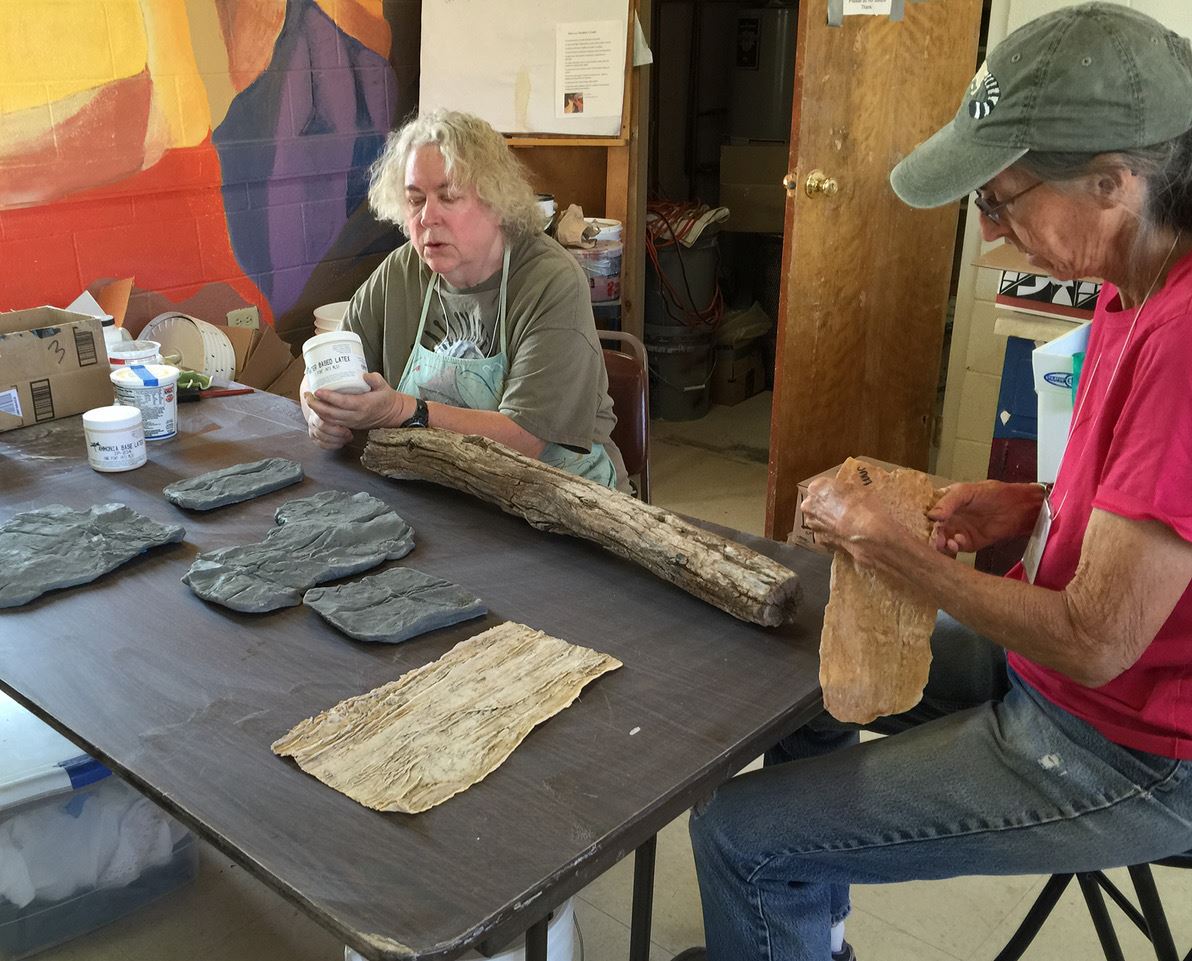
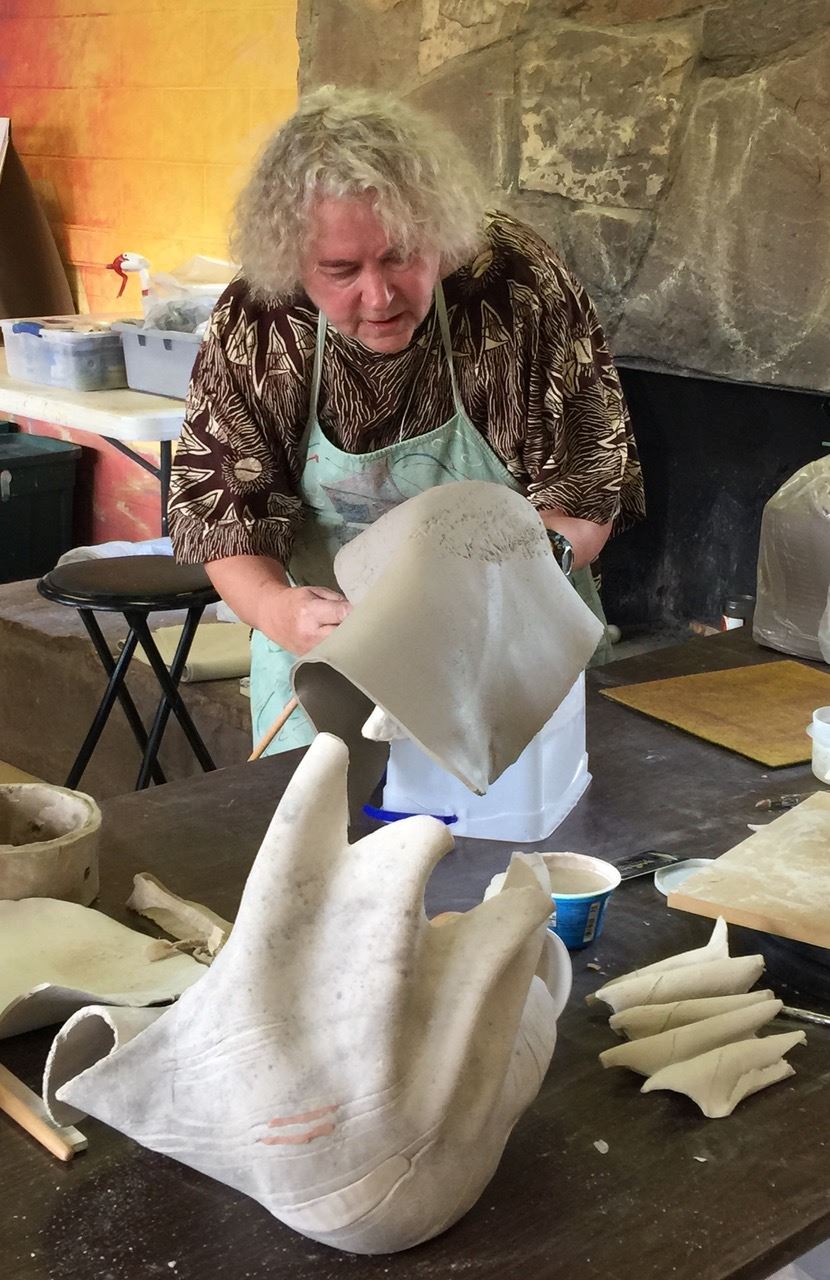
“Edge” workshop at Ghost Ranch: Paper Clay led by Judy Nelson-Moore, Soft Slab Construction led by Luisa Baldinger. Photos by Marta Rodeheffer
The experience of planning, presenting, taking, and talking to clay people over the years about Ghost Ranch experiences, led me to see that Ghost Ranch is a significant place for the ceramic arts, not just for me but for a lot of other people, and it had a potential I needed to help become fully realized. Barbara and I had this idea where we applied for the Armstrong Grant in 2008 to put in a cement floor. The Armstrong Grant gave us $1000. We worked with the grant and put a cement floor over the dirt in Pot Hollow. In conjunction, I raised a donation campaign among the members where we collected a sum of money for other projects. Then the Ranch put in the Raku pavilion about a year later. We really were able to make several improvements down in Pot Hollow.
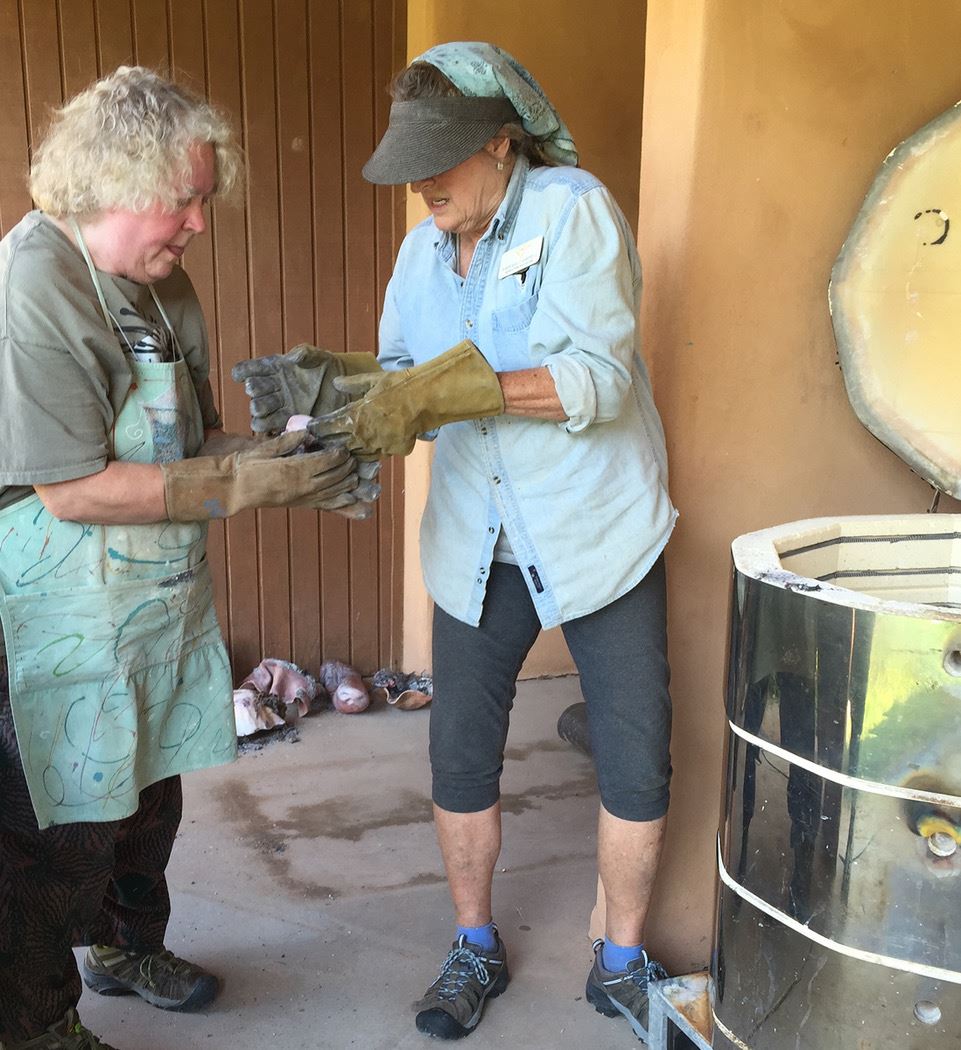
Judy and Barbara Campbell at Ghost Ranch. Photo by by Marta Rodeheffer
When the flood occurred in 2015, and we moved up to Piñon, we had a campaign to get money for the sun awning over the portal, so it wasn’t so difficult to work on the portal because the sun was really quite difficult in that location. So that was a significant expense. When Covid came along, and I saw the Ranch was struggling, I had this idea. First of all, Andrea Pichaida’s daughter, a graphic designer, developed these logos for the Celebration of Clay for about three years. They were beautiful logos, I felt. We hadn’t had any T-shirts or aprons for several years, and I thought we needed something to remember these logos by, if not the shows and workshops themselves. And then I got this idea: let’s use them as collateral to collect money for the Ranch. So, you know, I’m always coming up with ideas. I’m never short of ideas. Other people probably feel that’s unfortunate. (haha!) I always believe you cannot put forth an idea and then step back and say, okay, everybody else, you do that idea. That’s not fair; that’s not right. So, I started pitching the idea and dedicated myself to making it happen. That’s how the Clay Forward campaign started. I had a wonderful group of artists on the committee (Cirrelda Snider-Bryan, Luisa Baldinger, and Merlene Walker). I thought we had a brilliant idea to call it Clay Forward, and we met our goal, plus more. Everyone now wears their shirts and aprons happily. Well, strangely, when Barbara Campbell was investigating how were going to use that money, she found out that the Ranch had been holding on to some money designated for the ceramic art studio for quite some time. So, there’s more money there than we even thought there was.
Another program I am supportive of for the NMPCA is the Armstrong Grant. I knew Bill Armstrong, and he was a great guy. He was selfless in his contributions to the New Mexico Potters.
The Armstrong Grant was initially set up for $500. And we later increased it to $1000. We need to increase the amount. When we receive an application for more than $1000 or applications we want to award, and it’s more than $1000, the board does award them. Because we have some money in our savings, we can do increase the award for good reason. At an annual meeting several years ago, when we were giving the treasurer report, some members asked what we were doing with all that money. Let’s do something with it, they said. I’ve been conscious of discussion for several years. In the past, we didn’t always get applications for the Grant, and I think part of the reason is it’s such a paltry amount nobody wants to go to the trouble to apply for it.
The Slip Trail: You lent the organization your computer savvy in many ways. Wasn’t the motivation always to bring people together more easily? Can you reminisce on that process of converting to an online presence?
Judy Nelson-Moore: First, I want to say, after the Annual Meeting this year, Kathy Cyman came to me and said something wonderful. I think it reflects where we’ve come as an organization. She said, “Judy, I think the NMPCA would not be where it is now without you and your computer skills and putting us online and all the communication that has occurred.” I felt like this was a good reason for all the hours of work I had spent on developing the technical side of the organization. I started because it seemed I was the only person in the organization who could. The initial motivation was to get the word out about who we were and our activities, the workshops, and grants. I felt like people didn’t know what was going on. The motivation was also to raise what we now call the “profile” of the NMPCA, the public side, that was the website side, and the member side, all the communications, the emails, the newsletter, to get the word out among the members, to give the members some value, to make them know this is a happening organization, it’s well worth your participation. And I think this value has come to pass.
Bringing people together more easily was really the goal of the Zoom calls, with the Clay Connections, starting during COVID lockdown when we couldn’t meet in person. Being a statewide organization, it was always difficult for us to meet in person anyway. Clay Connections became an ongoing activity because it filled a need to connect beyond local areas. I think it’s a great way for people to connect. And people are more interested in connecting now than they were before.
In those early “transition-to-online” years, we also evolved to have several websites. In the early days of WordPress, it didn’t seem possible to do more than one function on a WordPress site. I started one for the main website to publicize who we are and what we are about. Then, I started another website for the Studio Tour. I think the Studio Tour is one of my most significant contributions. It was another one of my brainchild ideas (chuckles). I felt like this was to be of significant value to members. It was when internet searching was increasing, and it enabled the artist, for a very low cost, to have their presence on the internet to show their work. I think this was very helpful. So the studio tour was the second site. Then there was The Slip Trail, the blog. The Slip Trail has had so many generations. It was initially a mailed mimeographed paper publication. Penne Roberts was the editor for many years, as well as other editors. The postage was getting very expensive. The newsletter editors had trouble getting anybody to give them any input. We changed it to every other month, then to quarterly. And one meeting, the board was at my house, actually right here in this room where we are talking, and the board said, “Why don’t we have an online blog?” Then they all turned to me (big smile). And so, I implemented another WordPress site for the blog. The fourth one was for show applications. When you have even a non-juried show, you need some way of determining how many people to accept and collect their entries for tracking and labeling.
Then the WordPress sites became too unwieldy, and I began to realize, although they were nice sites and a credit to our organization, WordPress was not a tool just anybody could work with. It’s a difficult tool, and you need to be technically minded, especially with all the functionality we use. You almost need to have a full-time person. And the board kept saying, “Well, Judy, we’ll just hire you to be the person.” I finally decided we needed to convert to something else. In the meantime, we decided to utilize Wild Apricot for membership records, dues tracking, and payments. The credit goes to Cricket Appel. She’s the one who identified the “content management system” (the official word for it). We converted all our membership records. It’s a great system to maintain membership records; it sends notifications when it’s time to renew membership, plus it enables us to register events, so we put the show applications on there, along with workshops. Wild Apricot accepts online payments. It is also a fairly adequate website and email tool. But I said to the board: we must have something people can manage easily. Multiple WordPress sites did not work for easy maintenance. We decided to consolidate everything into Wild Apricot. So, we went into a big project. It took us about six months, and people helped me. We converted all our functionality into Wild Apricot. And it works reasonably well. We had to convert all of the Studio Tours; we had galleries of previous shows we converted, and we had the Slip Trail articles; it was a big effort.
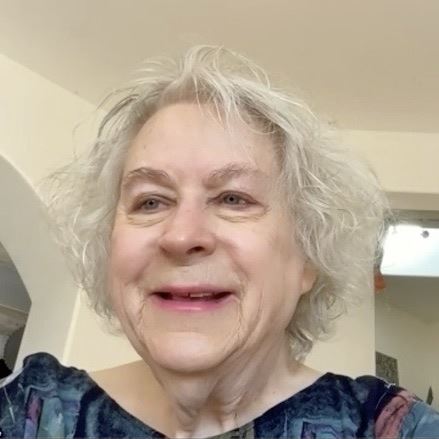
Judy during the interview. Photo credit: Cirrelda Snider-Bryan
The Slip Trail: Almost our last question: You were involved on an administrative level with NMPCA for twenty years. You took on many roles. You took your required year off, but then you joined back on after six years, three times. Are there any anecdotes you wish to share about the various roles you took on the board over the years? Treasurer, President, Vice President, Webmaster, all the different roles.
Judy Nelson-Moore: I have worked in a business for many years. I was a manager in a computer software business. I worked as a consultant, I worked with clients. That experience was invaluable in all the roles I later took on the NMPCA. However, I quickly discovered the differences between working with business clients and clay artist volunteers in the NMPCA. My best role in the business environment was as a consultant, helping people. I’d let them make the decisions, and I could just help them implement them. This skill came into play in leadership roles within the NMPCA. When I was NMPCA president, we had some difficult decisions and times when communication within the board was difficult. But there’s one very important action we took: We made an operations’ manual. Sara D'Alessandro, Barbara Campbell, and I attended a Santa Fe Business Institute workshop. They gave a workshop on non-profits and how they should operate. After the workshop, we created the operations’ manual. It’s on the website. Unfortunately, many people have forgotten about it. So, my final advice is to pay attention to the manual. It can be updated and changed to meet current circumstances, but it can give guidance if questions arise and communications get confused.
The Slip Trail: Brava, good. Looking into the future, do you have an idea for the future of the NMPCA and your own direction in creativity?
Judy Nelson-Moore: I hope for the NMPCA to expand its role in the Arts Community, emerging as a key organization to advocate for creativity in ceramic arts. Creativity, a vital tool for personal and organizational growth, finds unique expression through clay. The tactile experience of molding clay connects artists intimately with their creations, fostering a powerful, restorative, and exciting process. The NMPCA can attract a diverse community, solidifying its position as a driving force in the intersection of art and craftsmanship and inspiring a new generation of clay artists dedicated to increasing creativity in our world.
In my personal exploration with clay, I've entered a phase where commercial motivations no longer drive my creative pursuits. This direction stems from a transformative shift in my creative journey. My focus has evolved towards a profound love for experimentation and exploration in the realm of ceramics: alternative firing methods, alternative surfaces, unfettered shapes, unfired and mixed media combinations. Experimenting with effects, and methods has become an intrinsic goal in itself. The works that emerge are a genuine manifestation, either flowing intuitively from my hands or taking shape from the canvas of my dreams ... My desire is to persist in crafting with energy, unbridled freedom, and share my love of clay with others.
The Slip Trail: What a completely successful interview. I applaud your words and your thinking. Thank you so much, Judy.
Judy Nelson-Moore: You’re very welcome. I am so thankful to you for helping me with this process. I’ve wanted to get something in the Slip Trail to make these stories known.
- This conversation has been edited for length and clarity.
To see Judy’s ceramic work, go to her studio tour page at www.judynelsonmoore.com and her website at www.nmpotters.org/judy-nelson-moore
Also, to read Judy's article "The Monster From Within or How I Became an Artist," visit this link.


